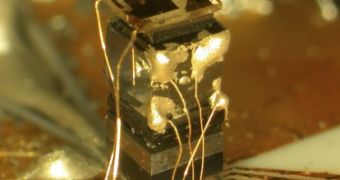The legendary battle between chipmakers AMD and Intel tends to expand beyond the market figures. The companies are caught in a struggle for experts to boost their technologies. It's fashionable to own a system-on-chip design team to pave the road for a time when GPUs and CPUs will peacefully coexist within a single chip.
AMD yesterday announced that they have named Mike Uhler as chief of "Accelerated Computing" group, to coordinate the Geode system-on-a-chip platform. Their program focuses on the distribution of tasks on a network of chips and cores, so that each specialized unit gets only the data it can process most efficiently.
On the other side of the fence, Intel have recently appointed their system-on-a-chip program to Gadi Singer, the one responsible for the Pentium M mobile processor, that would lately become the cornerstone for the Core 2 Quad design. Intel has already come out with four system-on-chip models: Tolapai for storage networks, Silverthorne for handhelds, Canmore for wired consumer devices and Larabee for high-end visualization systems.
'Every major element being developed going forward will be done in a way that makes it reusable', said Singer, who led Intel's efforts on its Pentium, Itanium and cellular processors and has been head of design automation software at the company. 'We are defining practices, flows and architectures that will allow plug-and-play across all Intel products', he said of the new group.
The system-on-chip approach is an older dream in the industry. The predecessors were Intel's Timna (who never made it to the shelves) or the National Semiconductor's Geode that is now AMD's property. These chips combined graphics and computing cores; things are somewhat different now, since the progress in the field has morphed CPUs and GPUs into massive elements that can not be painlessly integrated.
AMD is confident in the Accelerated Computing approach and expects Uhler to make use of his SGI experience for boosting their actual technology:
"AMD's vision for Accelerated Computing, unveiled at the close of the AMD/ATI merger in 2006, calls for the increasing use of accelerators to offload certain workloads from the CPU and process them at higher speeds and efficiency levels. This balancing of workload computation across multiple chips and cores, allowing each to do what it does best, stands to dramatically improve overall system performance and energy-efficiency, while also enabling systems to be highly optimized for a specific set of tasks based on the unique priorities of the particular end-user segment."

 14 DAY TRIAL //
14 DAY TRIAL //